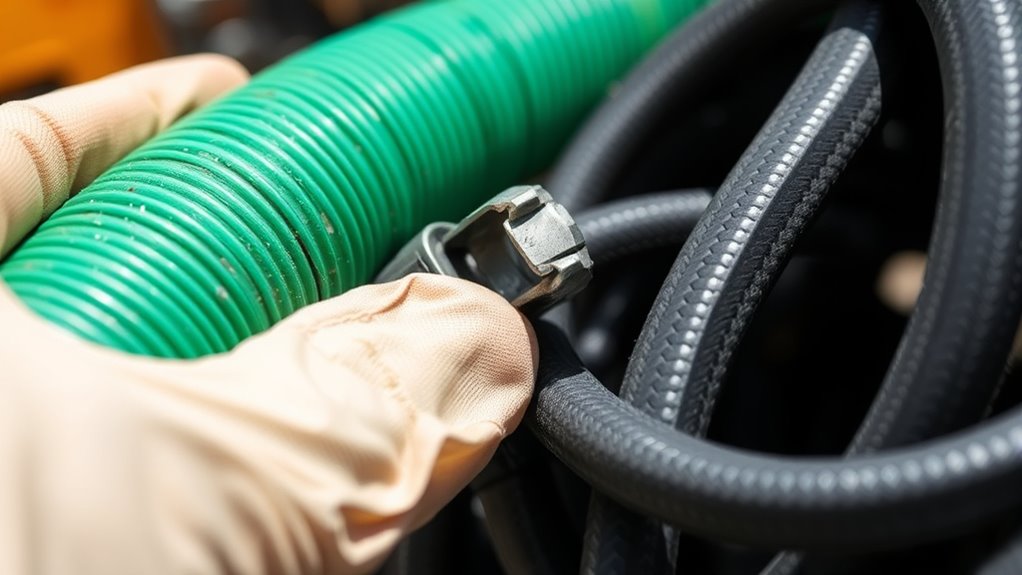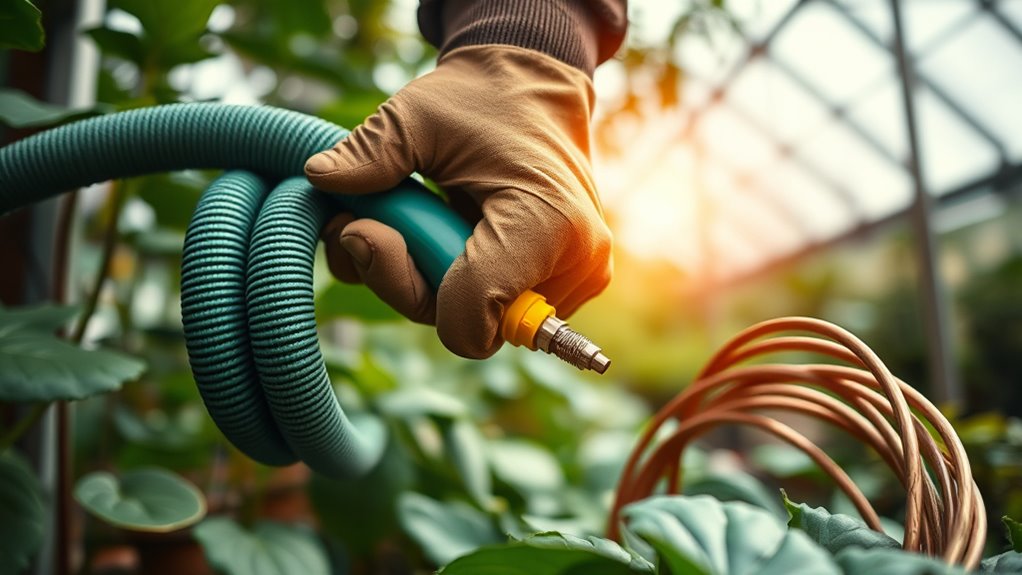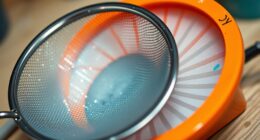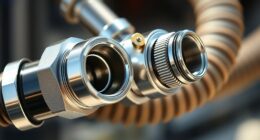To extend the life of hoses and cords on sprayer equipment, regularly inspect and replace damaged parts to prevent leaks and failures. Handle hoses carefully, store them properly out of sunlight, and avoid kinks or sharp bends. Keep filters clean to reduce pressure issues, and calibrate nozzles for efficiency. Also, inspect and maintain connections to prevent wear. Continuing with these tips will help keep your equipment running smoothly and last longer.
Key Takeaways
- Regularly inspect hoses and cords for signs of wear, cracks, or leaks, and replace damaged parts promptly.
- Store hoses loosely coiled and cords properly to prevent kinks, tangles, and mechanical stress.
- Handle hoses and cords carefully during use to avoid twisting, overstretching, or sharp bends.
- Clean filters and maintain proper flow to reduce pressure fluctuations that can damage hoses and cords.
- Ensure fittings are tight but not overtightened, and disconnect equipment carefully to prevent connection damage.

Regular maintenance is essential to keep your sprayer equipment functioning efficiently and prevent costly repairs. One key aspect of this is ensuring that your hoses and cords last as long as possible. Proper care minimizes wear and tear, reduces the risk of leaks, and keeps your sprayer operating smoothly. To achieve this, start by inspecting your hoses regularly for signs of damage, such as cracks, leaks, or brittleness. Replacing worn hoses promptly prevents pressure build-up and potential failures during application. When handling hoses, avoid sharp bends or kinks, which can weaken the material over time. Instead, store hoses properly when not in use, coiling them loosely and keeping them out of direct sunlight to prevent UV damage. Additionally, choosing hoses with appropriate material quality can significantly enhance durability and lifespan.
Another vital maintenance tip involves nozzle calibration. If your nozzles are not calibrated correctly, you might be overloading or under-delivering chemicals, which can cause uneven application and increase strain on your equipment. Proper nozzle calibration ensures that the spray pattern and flow rate are consistent, reducing unnecessary pressure on hoses and cords. This practice not only improves application efficiency but also extends the lifespan of your equipment by preventing over-pressurization that can lead to hose failure. Along with calibration, filter cleaning plays a crucial role in maintaining hose and cord integrity. Clogged filters can cause pressure fluctuations, forcing your pump and hoses to work harder than necessary. Regularly cleaning filters helps maintain proper flow rates, reducing stress on hoses and cords, and preventing buildup that could cause blockages or damage.
Additionally, paying attention to your cords—whether electrical or pneumatic—is equally important. Check cords for frays, cuts, or signs of deterioration, and replace damaged cords immediately. Proper storage of cords, avoiding tangling or excessive bending, helps prevent internal wire damage that could lead to shorts or failure. When connecting hoses and cords, ensure fittings are tight but not overtightened, as this can damage threads and cause leaks. Always disconnect hoses and cords carefully after use to avoid unnecessary stress on connection points.
Frequently Asked Questions
How Often Should Hoses and Cords Be Replaced?
You should regularly inspect your hoses and cords to determine when replacement is necessary. Typically, hoses need replacement if you notice cracks, leaks, or significant wear, while cords should be replaced if you see fraying or exposed wires. The cord replacement frequency depends on usage and exposure, but inspecting them monthly guarantees safety and efficiency. Staying proactive with hose inspection and timely cord replacement helps prevent equipment failures and extends their lifespan.
Can Using Incompatible Chemicals Damage Sprayer Hoses?
A stitch in time saves nine, so always check chemical compatibility to protect your sprayer hoses. Using incompatible chemicals can cause damage, weakening or degrading the hose material. To guarantee hose protection, only use chemicals recommended by the manufacturer. This proactive approach prevents costly repairs and extends your equipment’s lifespan. Remember, proper maintenance and chemical awareness are key to keeping your sprayer hoses in top condition.
What Are Signs of Hose or Cord Wear Before Failure?
You should regularly inspect your hoses and cords for signs of wear before failure. Look for cracks, leaks, or brittleness in the hoses, and check for cord fraying or exposed wires. These indicators suggest the equipment may soon fail, so taking action early can prevent accidents. Consistent hose inspection helps you catch issues early, ensuring safe operation and prolonging the life of your sprayer equipment.
Are There DIY Methods to Extend Hose and Cord Lifespan?
A stitch in time saves nine, so DIY repairs and proper storage tips can markedly extend your hose and cord lifespan. You can replace worn-out sections, use protective coverings, or gently coil hoses to prevent kinks. Store equipment in a cool, dry place, avoiding sunlight and sharp objects. Regular inspections and timely repairs keep your sprayer equipment functioning smoothly, saving money and avoiding unexpected failures.
How Do Weather Conditions Affect Hose and Cord Durability?
Weather impact considerably affects your hose and cord durability. Temperature fluctuations cause materials to expand and contract, weakening the fibers over time. Exposure to extreme heat can make hoses and cords brittle, while cold temperatures may make them stiff and crack-prone. Humidity and moisture can lead to mold or corrosion. To protect your equipment, store hoses and cords indoors during harsh weather and avoid prolonged exposure to direct sunlight and extreme temperatures.
Conclusion
So, there you have it—your foolproof guide to making hoses and cords last forever… or at least a little longer. Follow these tips, stay vigilant, and you might just avoid the nightmare of sudden leaks or shocking surprises. Because nothing says “fun” like replacing equipment every season, right? Remember, a little maintenance now saves you from the disaster of expensive replacements later. Happy spraying—may your hoses stay intact and your cords stay shock-free!
Franz came aboard the Paint Sprayer Zone team with a background in both journalism and home renovation. His articulate writing style, combined with a passion for DIY projects, makes him an invaluable asset. Franz has a knack for breaking down technical jargon into easy-to-understand content, ensuring that even the most novice of readers can grasp the complexities of paint sprayers.










